16.10.2020

The ESA-JAXA BepiColombo mission has completed the first of two Venus flybys needed to set it on course with the Solar System’s innermost planet, Mercury.
The closest approach of the flyby took place at 03:58 GMT (05:58 CEST) this morning at a distance of about 10 720 km from the planet’s surface.
Launched 20 October 2018, the spacecraft needs nine gravity assist flybys – one at Earth, two at Venus and six at Mercury before entering orbit around the planet in 2025. Flybys ultilise the gravitational pull of the planets to help alter the speed and direction of the spacecraft, and together with the spacecraft’s solar electric propulsion system, help BepiColombo steer into Mercury orbit against the strong gravitational pull of the Sun.
The first flyby – of Earth – took place 10 April this year, returning poignant images of our home planet as the world faced lockdown due to the COVID-19 pandemic.
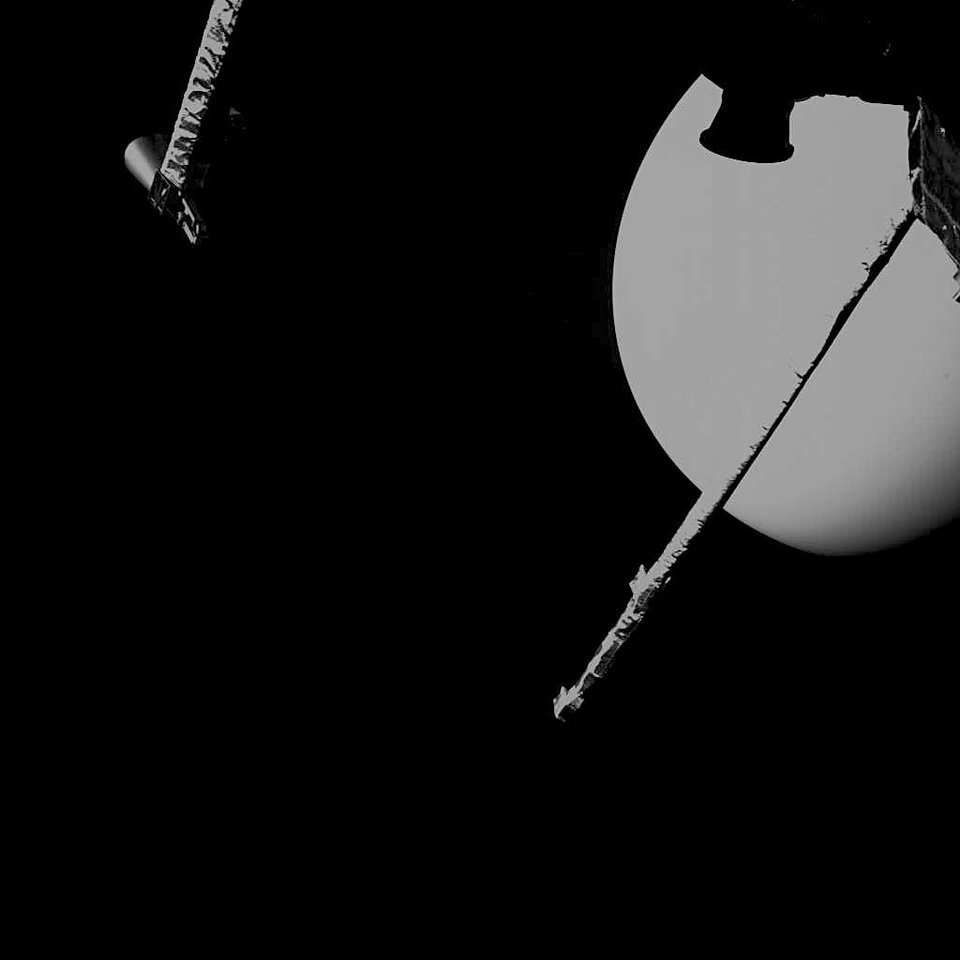
Flying by teleworking
“For the Venus flyby we conducted the large majority of our preparations over the last three months via teleworking, with only the minimum personnel required onsite during the flyby to ensure the safe operation of the spacecraft,” says Elsa Montagnon, ESA’s BepiColombo Spacecraft Operations Manager.
The on-site team at ESA’s mission control centre in Darmstadt, Germany, comprised four members of the flight control team split into two groups over a period of 36 hours, together with a ground station manager, and two team members joining around closest approach to manage the images as they were downloaded from the spacecraft.
“The flyby itself was very successful,” confirms Elsa. “The only difference to normal cruise phase operations is that near to Venus we have to temporarily close the shutter of any of the star trackers that are expected to be blinded by the planet, similar to closing your eyes to avoid looking at the Sun.”
Two of the three monitoring cameras onboard the Mercury Transfer Module were activated during dedicated imaging slots from 20 hours before closest approach through to 15 minutes afterwards. From afar, Venus is seen as a small disc in the camera’s field of view, close to the spacecraft body. During the closest approach phase the planet dominates the view, 'rising' behind the magnetometer boom of the Mercury Planetary Orbiter.
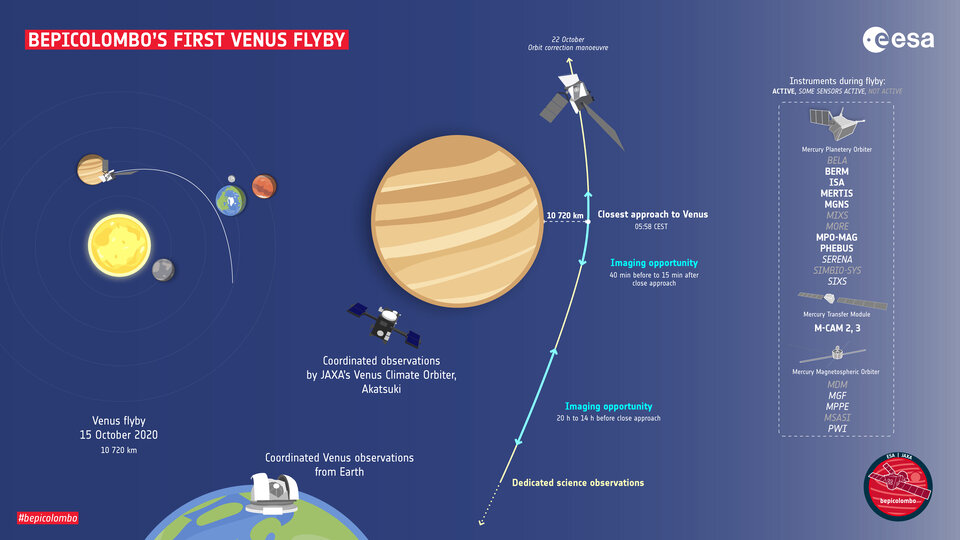
Science in the making
Seven of the eleven science instruments onboard the European Mercury Planetary Orbiter, plus its radiation monitor, and three of five onboard the Japanese Mercury Magnetospheric Orbiter were active during the flyby. While the suite of sensors are designed to study the rocky, atmosphere-free environment at Mercury, the flyby offered a unique opportunity to collect valuable science data at Venus.
“Following the successful Earth flyby where our instruments worked even better than expected, we are looking forward to see what will come out of the Venus flyby,” says Johannes Benkhoff, ESA’s BepiColombo Project Scientist.
“We’ll have to be patient while our Venus specialists look carefully into the data, but we hope to be able to provide some atmosphere temperature and density profiles, information about the chemical composition and cloud cover, and on the magnetic environment interaction between the Sun and Venus. But we rather anticipate more results next year than now, given the closer flyby distance, so watch this space!”
The 2021 flyby, planned for 10 August, will see the spacecraft pass within just 550 km of the planet’s surface.
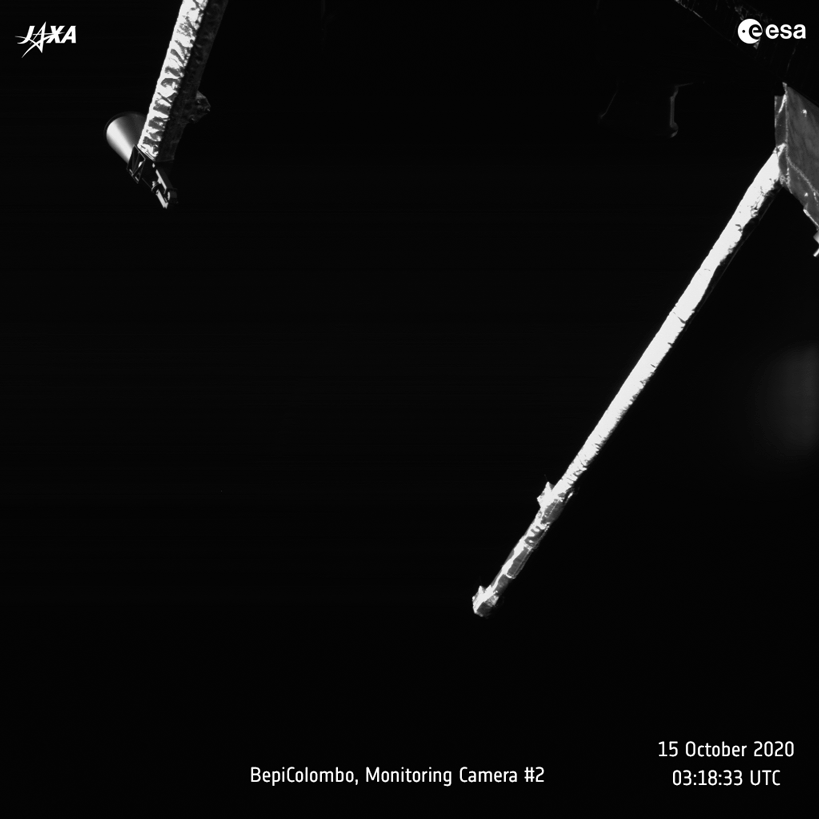
Telescope teamwork
Today’s encounter also provided the chance to make simultaneous measurements with JAXA’s Akatsuki Venus Climate Orbiter and its Earth-orbiting Hisaki Spectroscopic Planet Observatory, together with ground-based observatories to study Venus from multiple viewpoints and at different scales.
“Akatsuki is currently the only spacecraft in orbit around Venus and because of its elliptical orbit it was actually 30 times further away from the planet than BepiColombo during the flyby, meaning we can compare close observations of BepiColombo with Akatsuki’s global-scale view,” says Go Murakami, JAXA’s BepiColombo Project Scientist.
“A large campaign of coordinated observations are ongoing, involving professional and amateur astronomers alike, that will build a three-dimensional picture of what’s happening over time in Venus’ atmosphere, something that cannot be achieved by one spacecraft or one telescope alone," says Valeria Mangano, of the National Institute for Astrophysics in Italy, and chair of the Venus flyby working group.


Access the video
Next steps
While the science teams are busy diving into the new flyby data, the operations teams will assess the performance of the Venus flyby and make a routine trajectory correction of the spacecraft on 22 October. The next dedicated solar electric propulsion arc is planned for May 2021.
BepiColombo will also make its first Mercury flyby next year, in October, at a distance of just 200 km, providing the first tantalizing taste of what will follow once the mission’s two science orbiters have arrived in their dedicated orbits around the planet. There they will study Mercury’s mysteries, addressing numerous open questions in planetary science, such as: where in the Solar System did Mercury form? What is the nature of the ice in Mercury’s shadowed craters? Is the planet still geologically active? How can such a small planet still have a magnetic field?
“With each flyby completed we get a step closer to answering some of these perplexing questions about mysterious planet Mercury,” adds Johannes. “Learning more about Mercury will shed light on the history of the entire Solar System, helping us to better understand our own place in space.”
"While gravity assists have a practical function to set us on course for Mercury, it is wonderful to have these brief opportunities to observe Venus as we fly through the Solar System," says Simon Plum, ESA's Head of Mission Operations.
"Thanks to the teams who have been working hard behind the scenes over the last months to make this flyby a success. While we work with incredibly far distances and a tremendous amount of space as we navigate the Solar System, we are again dealing with special operations under pandemic situation, where space between our people matter and the safety of our colleagues remain the number one priority.”
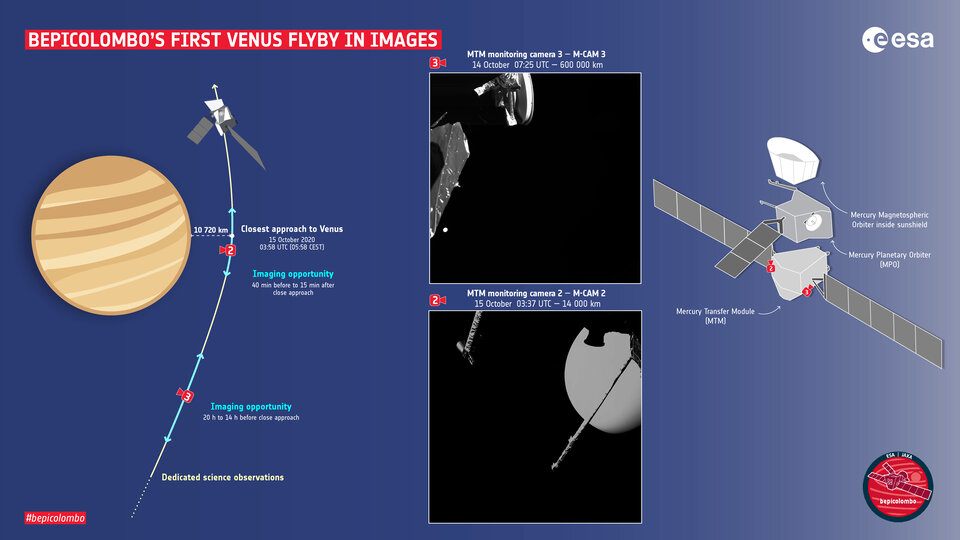
For updates on the upcoming operations activities and science data analysis follow the mission on Twitter via: @ESA_Bepi, @ESA_MTM and @BepiColombo
About BepiColombo
BepiColombo is Europe's first mission to Mercury. Launched on 20 October 2018, it is on a seven-year journey to the smallest and least explored terrestrial planet in our Solar System. The mission is a joint endeavour between ESA and the Japan Aerospace Exploration Agency (JAXA), carried out under ESA leadership.
BepiColombo comprises two scientific orbiters: ESA’s Mercury Planetary Orbiter (MPO) and JAXA’s Mercury Magnetospheric Orbiter (Mio). The European Mercury Transfer Module (MTM) carries the orbiters to Mercury. After arrival at Mercury in late 2025, the spacecraft will separate and the two orbiters will manoeuvre to their dedicated polar orbits around the planet. Starting science operations in early 2026, both orbiters will gather data during a one-year nominal mission, with a possible one-year extension.
The mission is named after the Italian mathematician and engineer Giuseppe (Bepi) Colombo (1920–84).
Quelle: ESA
----
Update: 29.09.2021
.
Mercury ahead!

The ESA/JAXA BepiColombo mission to Mercury will make the first of six flybys of its destination planet on 1 October before entering orbit in 2025.
Hot on the heels of its last Venus flyby in August, the spacecraft’s next exciting encounter is with Mercury at 23:34 UTC on 1 October (01:34 CEST 2 October). It will swoop by the planet at an altitude of about 200 km, capturing imagery and science data that will give scientists a tantalising first taste of what’s to come in the main mission.

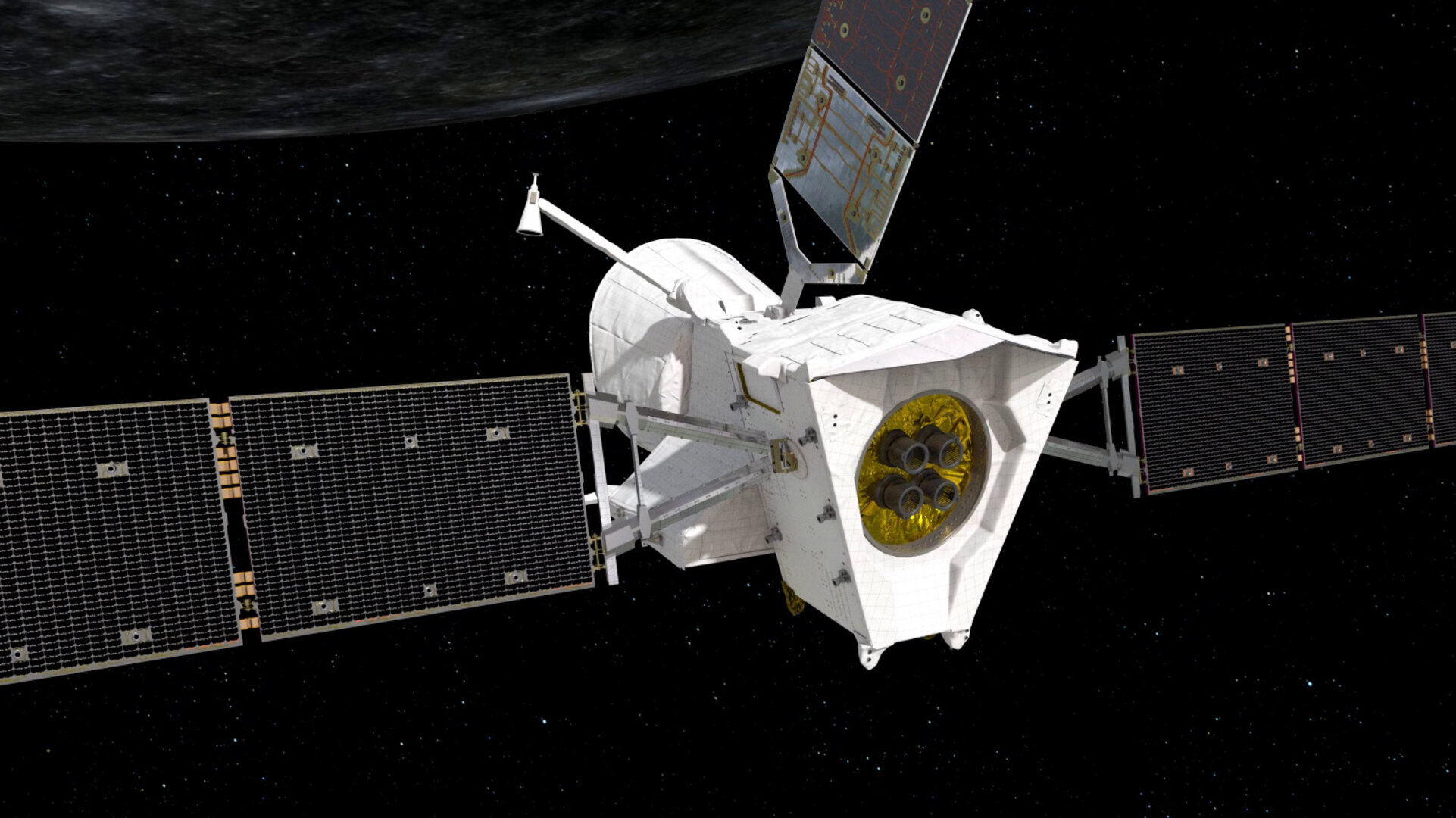
Access the video
The mission comprises two science orbiters which will be delivered into complementary orbits around the planet by the Mercury Transfer Module in 2025. The ESA-led Mercury Planetary Orbiter and the JAXA-led Mercury Magnetospheric Orbiter, Mio, will study all aspects of this mysterious inner planet from its core to surface processes, magnetic field and exosphere, to better understand the origin and evolution of a planet close to its parent star.
BepiColombo will make use of nine planetary flybys in total: one at Earth, two at Venus, and six at Mercury, together with the spacecraft’s solar electric propulsion system, to help steer into Mercury orbit.
On track for Mercury slingshot
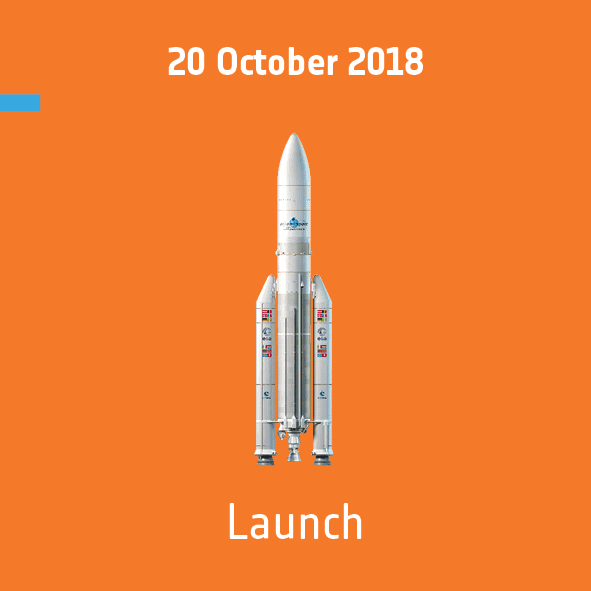
Gravitational flybys require extremely precise deep-space navigation work, ensuring that the spacecraft is on the correct approach trajectory.
One week after BepiColombo’s last flyby on 10 August, a correction manoeuvre was performed to nudge the craft a little for this first flyby of Mercury, targeting an altitude of 200 km. At present, the craft is predicted to pass the innermost planet at 198 km, and small adjustments can easily be made with solar electric propulsion manoeuvres after the swing-by. As BepiColombo is more than 100 million km away from Earth, with light taking 350 seconds (about six minutes) to reach it, being on target to within just two kilometres is no easy feat.
“It is because of our remarkable ground stations that we know where our spacecraft is with such precision. With this information, the Flight Dynamics team at ESOC know just how much we need to manoeuvre, to be in the right place for Mercury’s gravitational assist,” explains Elsa Montagnon, Spacecraft Operations Manager for the mission.
“As is often the case, our mission’s path has been planned so meticulously that no further correction manoeuvres are expected for this upcoming flyby. BepiColombo is on track."
First glimpse of Mercury
During the flybys it is not possible to take high-resolution imagery with the main science camera because it is shielded by the transfer module while the spacecraft is in cruise configuration. However, two of BepiColombo’s three monitoring cameras (MCAMs) will be taking photos from about five minutes after the time of close approach and up to four hours later. Because BepiColombo is arriving on the planet’s nightside, conditions are not ideal to take images directly at the closest approach, thus the closest image will be captured from a distance of about 1000 km.
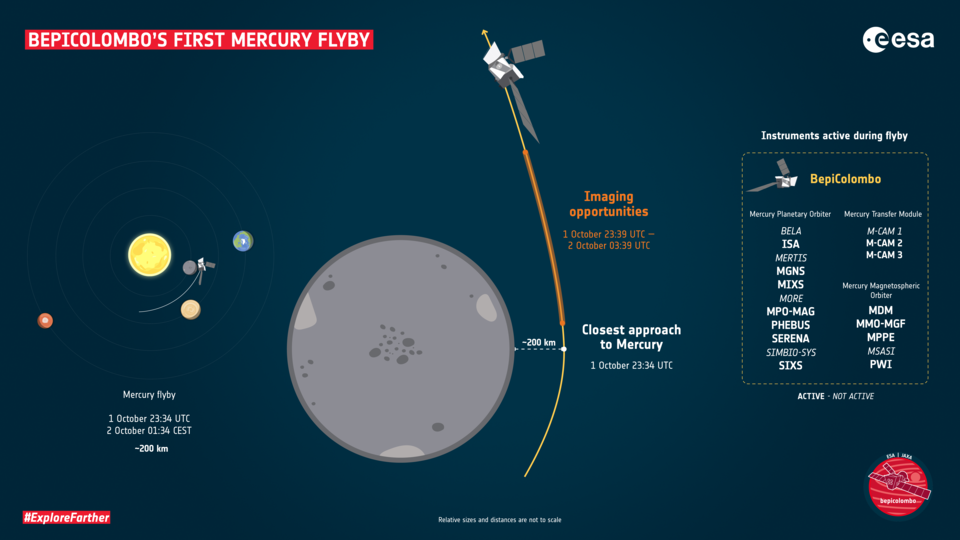
The first image to be downlinked will be from about 30 minutes after closest approach, and is expected to be available for public release at around 08:00 CEST on Saturday morning. The close approach and subsequent images will be downlinked one by one during Saturday morning.
The cameras provide black-and-white snapshots in 1024 x 1024 pixel resolution, and are positioned on the Mercury Transfer Module such that they also capture the spacecraft’s solar arrays and antennas. As the spacecraft changes its orientation during the flyby, Mercury will be seen passing behind the spacecraft structural elements.
In general, MCAM-2 will point towards the northern hemisphere of Mercury, while MCAM-3 will point towards the southern hemisphere. During the half hour following the close approach, imaging will alternate between the two cameras. Later imaging will be performed by MCAM-3.
For the closest images it should be possible to identify large impact craters on the planet’s surface. Mercury has a heavily cratered surface much like the appearance of Earth’s Moon, plotting its 4.6 billion year history. Mapping the surface of Mercury and analysing its composition will help scientists understand more about its formation and evolution.
Even though BepiColombo is in ‘stacked’ cruise configuration for the flybys, it will be possible to operate some of the science instruments on both planetary orbiters, allowing a first taste of the planet’s magnetic, plasma and particle environment.
“We’re really looking forward to seeing the first results from measurements taken so close to Mercury’s surface,” says Johannes Benkhoff, ESA’s BepiColombo project scientist. “When I started working as project scientist on BepiColombo in January 2008, NASA’s Messenger mission had its first flyby at Mercury. Now it’s our turn. It’s a fantastic feeling!”
Celebrating BepiColombo’s namesake
The upcoming first Mercury flyby falls on the 101st anniversary of the birth of Giuseppe 'Bepi' Colombo (2 October 1920–20 February 1984), an Italian scientist and engineer for whom the BepiColombo mission is named. Colombo is known for explaining Mercury's peculiar characteristic of rotating about its own axis three times in every two orbits of the Sun. He also realised that by careful choice of a spacecraft’s flyby point as it passed a planet, the planet’s gravity could help the spacecraft make further flybys. His interplanetary calculations enabled NASA’s Mariner 10 spacecraft to achieve three flybys of Mercury instead of one by using a flyby of Venus to change the spacecraft’s flight path – the first of many spacecraft to use such a gravity assist manoeuvre.
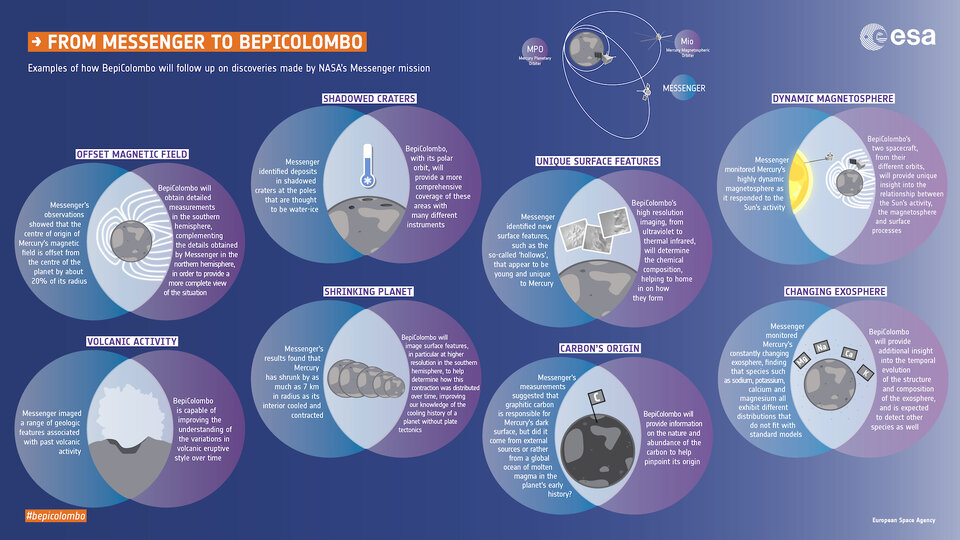
Following Mariner 10’s mission in 1974-75, NASA’s Messenger spacecraft flew by Mercury three times in 2008-09 and orbited the planet for four years (2011-2015). The BepiColombo mission will build on the successes of its predecessors to provide the best understanding of the Solar System’s innermost planet to date.
Follow the flyby
Follow @Esaoperations and @bepicolombo together with @ESA_Bepi, @ESA_MTM and @JAXA_MMO for updates.
The first image is expected to be released early in the morning of Saturday 2 October (provisionally 08:00 CEST); subsequent images may be released later in the day on Saturday and/or Monday 4 October. Additional science commentary may also be available in the week following the flyby. Timings subject to change depending on actual spacecraft events and image availability.
Quelle: ESA
----
Update: 3.10.2021
.
Europe, Japan probes to get 1st look at destination Mercury
A joint European-Japanese spacecraft is set to fly by Mercury for the first time on its path to deliver two probes into the planet's orbit in 2025

BERLIN -- A joint European-Japanese spacecraft is set to fly by Mercury for the first time late Friday on its path to deliver two probes into the planet's orbit in 2025.
The BepiColombo mission will make the first of six flybys of Mercury at about 2334 GMT (1934 EST), using the planet's gravity to slow itself down.
As it passes by Mercury down to an altitude of 200 kilometers (125 miles) the spacecraft will gather its first data and images before zooming off again.
The joint mission by the European Space Agency and Japan Aerospace Exploration Agency was launched in 2018, flying once past Earth and twice past Venus on its journey to the innermost planet of the solar system.
The mission is named after Italian scientist Giuseppe ‘Bepi’ Colombo, who is credited with helping develop the gravity assist maneuver that NASA’s Mariner 10 first used when it flew to Mercury in 1974.
Quelle: abcNews
+++
BepiColombo’s first views of Mercury

The ESA/JAXA BepiColombo mission has captured its first views of its destination planet Mercury as it swooped past in a close gravity assist flyby last night.
The closest approach took place at 23:34 UTC on 1 October at an altitude of 199 km from the planet’s surface. Images from the spacecraft’s monitoring cameras, along with scientific data from a number of instruments, were collected during the encounter. The images were already downloaded over the course of Saturday morning, and a selection of first impressions are presented here.
“The flyby was flawless from the spacecraft point of view, and it’s incredible to finally see our target planet,” says Elsa Montagnon, Spacecraft Operations Manager for the mission.
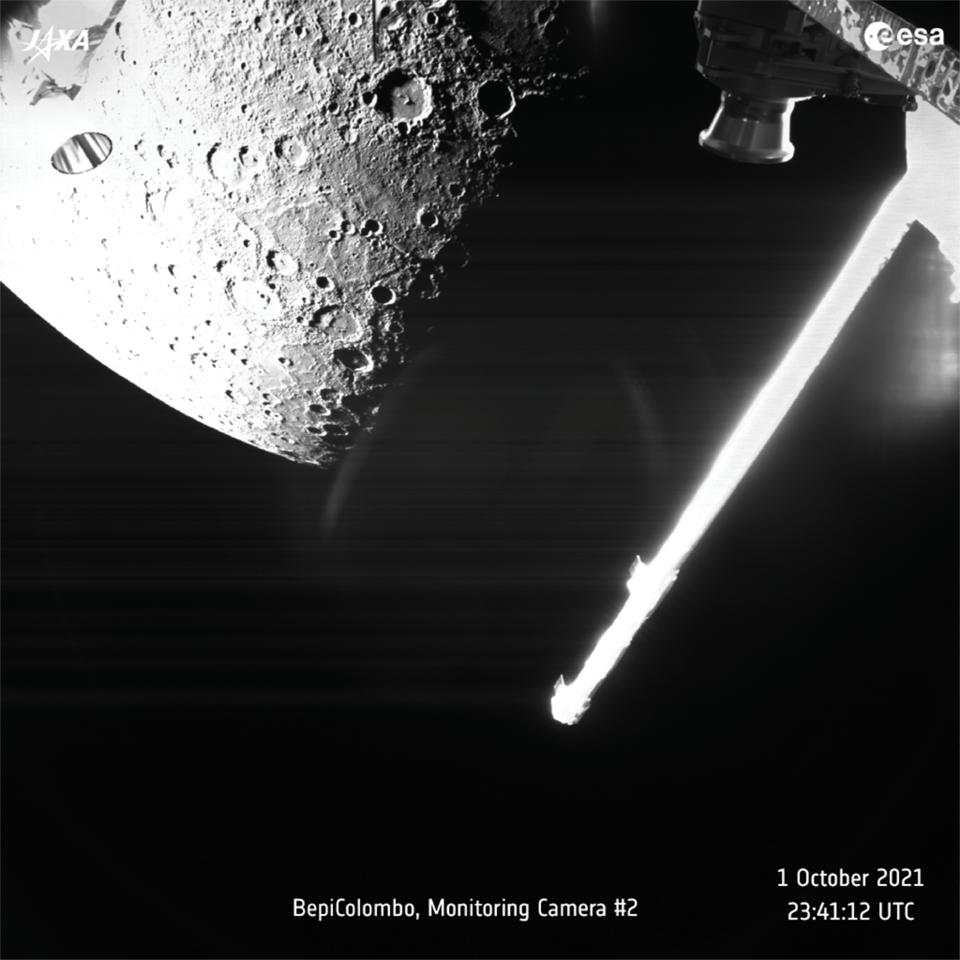
The monitoring cameras provide black-and-white snapshots in 1024 x 1024 pixel resolution, and are positioned on the Mercury Transfer Module such that they also capture the spacecraft’s structural elements, including its antennas and the magnetometer boom.
Images were acquired from about five minutes after the time of close approach and up to four hours later. Because BepiColombo arrived on the planet’s nightside, conditions were not ideal to take images directly at the closest approach, thus the closest image was captured from a distance of about 1000 km.
In many of the images, it is possible to identify some large impact craters (click to expand captions for more details of individual images).
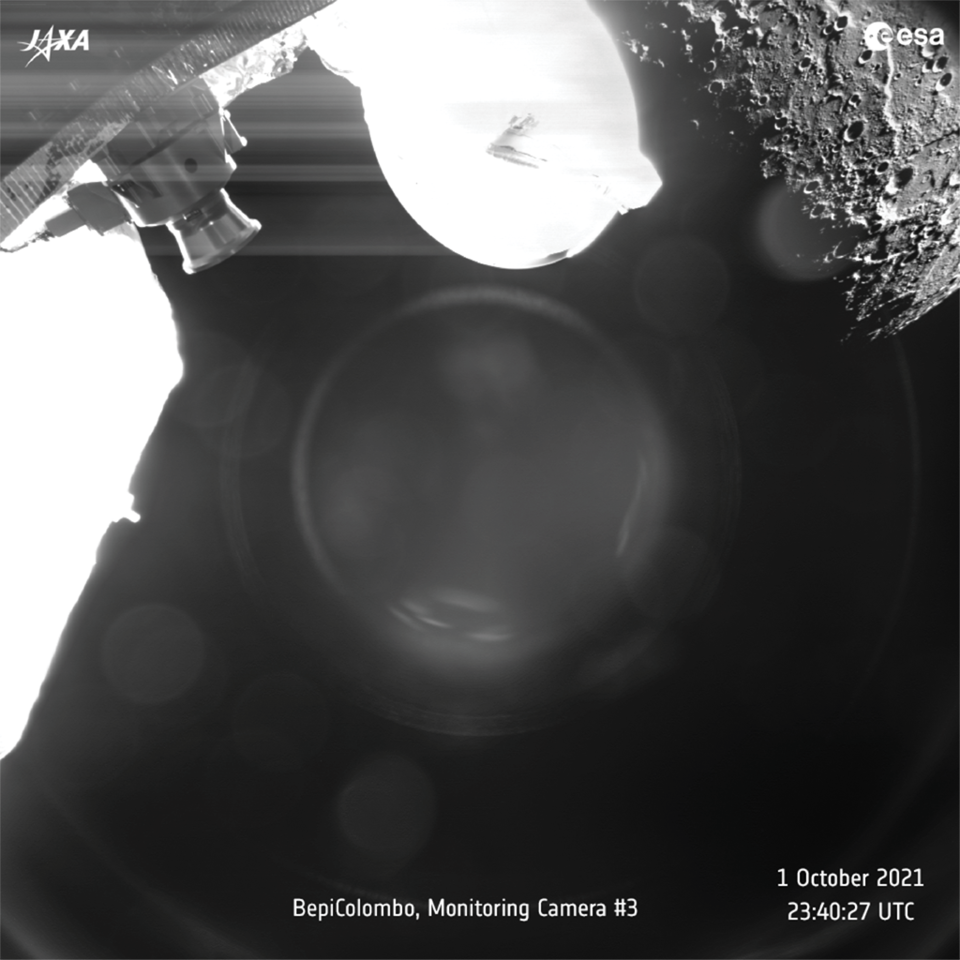
“It was an incredible feeling seeing these almost-live pictures of Mercury,” says Valetina Galluzzi, co-investigator of BepiColombo’s SIMBIO-SYS imaging system that will be used once in Mercury orbit. “It really made me happy meeting the planet I have been studying since the very first years of my research career, and I am eager to work on new Mercury images in the future.”
“It was very exciting to see BepiColombo’s first images of Mercury, and to work out what we were seeing,” says David Rothery of the UK’s Open University who leads ESA’s Mercury Surface and Composition Working Group. “It has made me even more enthusiastic to study the top quality science data that we should get when we are in orbit around Mercury, because this is a planet that we really do not yet fully understand.”
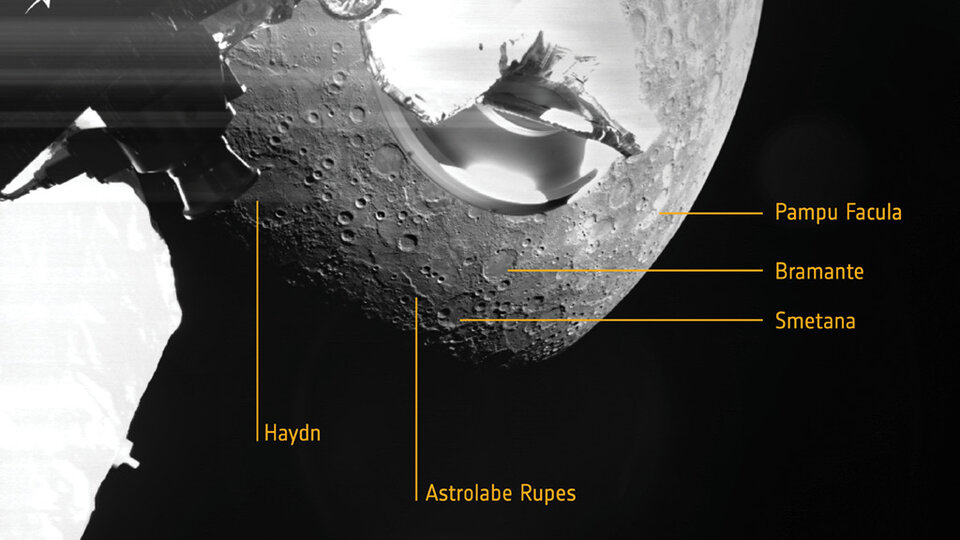
Although the cratered surface looks rather like Earth’s Moon at first sight, Mercury has a much different history. Once its main science mission begins, BepiColombo’s two science orbiters – ESA’s Mercury Planetary Orbiter and JAXA’s Mercury Magnetospheric Orbiter – will study all aspects of mysterious Mercury from its core to surface processes, magnetic field and exosphere, to better understand the origin and evolution of a planet close to its parent star. For example, it will map the surface of Mercury and analyse its composition to learn more about its formation. One theory is that it may have begun as a larger body that was then stripped of most of its rock by a giant impact. This left it with a relatively large iron core, where its magnetic field is generated, and only a thin rocky outer shell.
Mercury has no equivalent to the ancient bright lunar highlands: its surface is dark almost everywhere, and was formed by vast outpourings of lava billions of years ago. These lava flows bear the scars of craters formed by asteroids and comets crashing onto the surface at speeds of tens of kilometers per hour. The floors of some of the older and larger craters have been flooded by younger lava flows, and there are also more than a hundred sites where volcanic explosions have ruptured the surface from below.
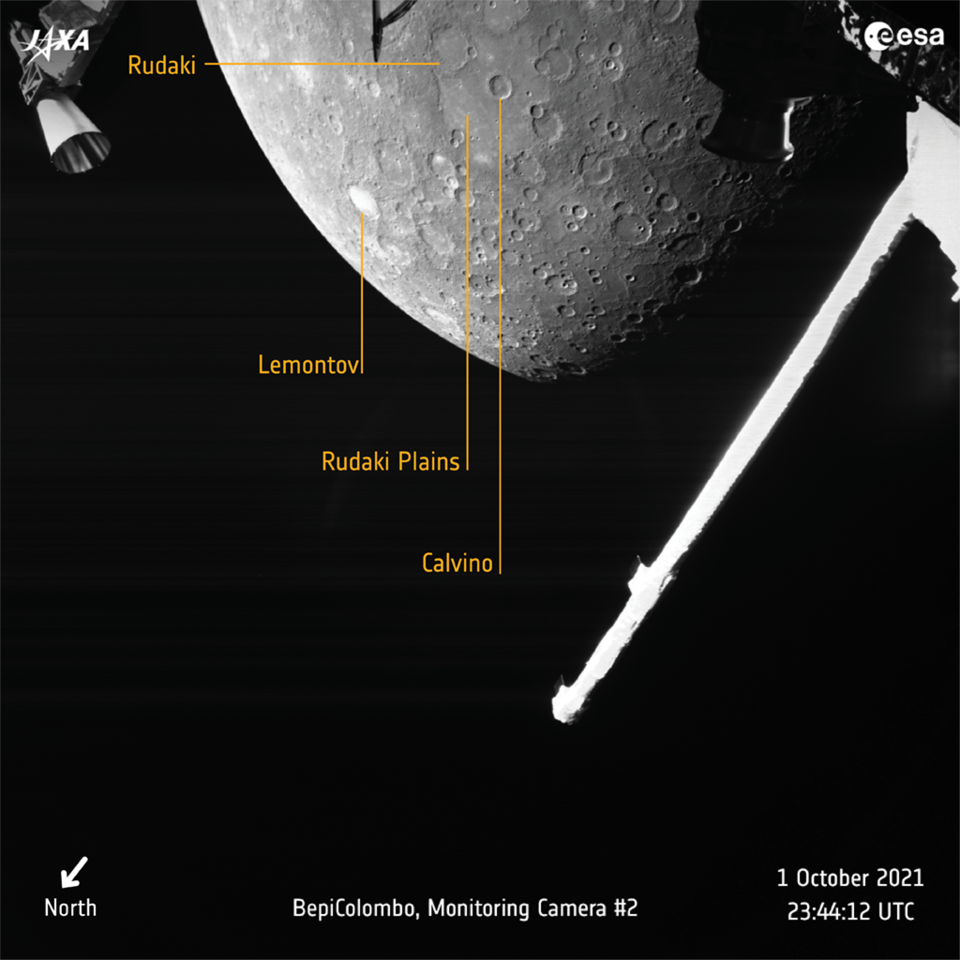
BepiColombo will probe these themes to help us understand this mysterious planet more fully, building on the data collected by NASA’s Messenger mission. It will tackle questions such as: What are the volatile substances that turn violently into gas to power the volcanic explosions? How did Mercury retain these volatiles if most of its rock was stripped away? How long did volcanic activity persist? How quickly does Mercury’s magnetic field change?
“In addition to the images we obtained from the monitoring cameras we also operated several science instruments on the Mercury Planetary Orbiter and Mercury Magnetospheric Orbiter,” adds Johannes Benkhoff, ESA’s BepiColombo project scientist. “I’m really looking forward to seeing these results. It was a fantastic night shift with fabulous teamwork, and with many happy faces.”
BepiColombo’s main science mission will begin in early 2026. It is making use of nine planetary flybys in total: one at Earth, two at Venus, and six at Mercury, together with the spacecraft’s solar electric propulsion system, to help steer into Mercury orbit. Its next Mercury flyby will take place 23 June 2022.
Quelle: ESA
----
Update: 16.10.2021
.
BepiColombo’s first tastes of Mercury science
The magnetic and particle environment around Mercury was sampled by BepiColombo for the first time during the mission’s close flyby of the planet at 199 km on 1-2 October 2021, while the huge gravitational pull of the planet was felt by its accelerometers.
The magnetic and accelerometer data have been converted into sound files and presented here for the first time. They capture the ‘sound’ of the solar wind as it bombards a planet close to the Sun, the flexing of the spacecraft as it responded to the change in temperature as it flew from the night to dayside of the planet, and even the sound of a science instrument rotating to its ‘park’ position.
Unexplored territory
“It may have been a fleeting flyby, but for some of BepiColombo’s instruments, it marked the beginning of their science data collection, and a chance to really start preparing for the main mission,” says Johannes Benkhoff, ESA’s BepiColombo project scientist. “These flybys also offer the chance to sample regions around Mercury that will not be accessible once we’re in orbit. In this case BepiColombo provided us insight into the particles present close to the planet, as well as the magnetic field boundaries as it traversed through the magnetosphere at greater distances.”

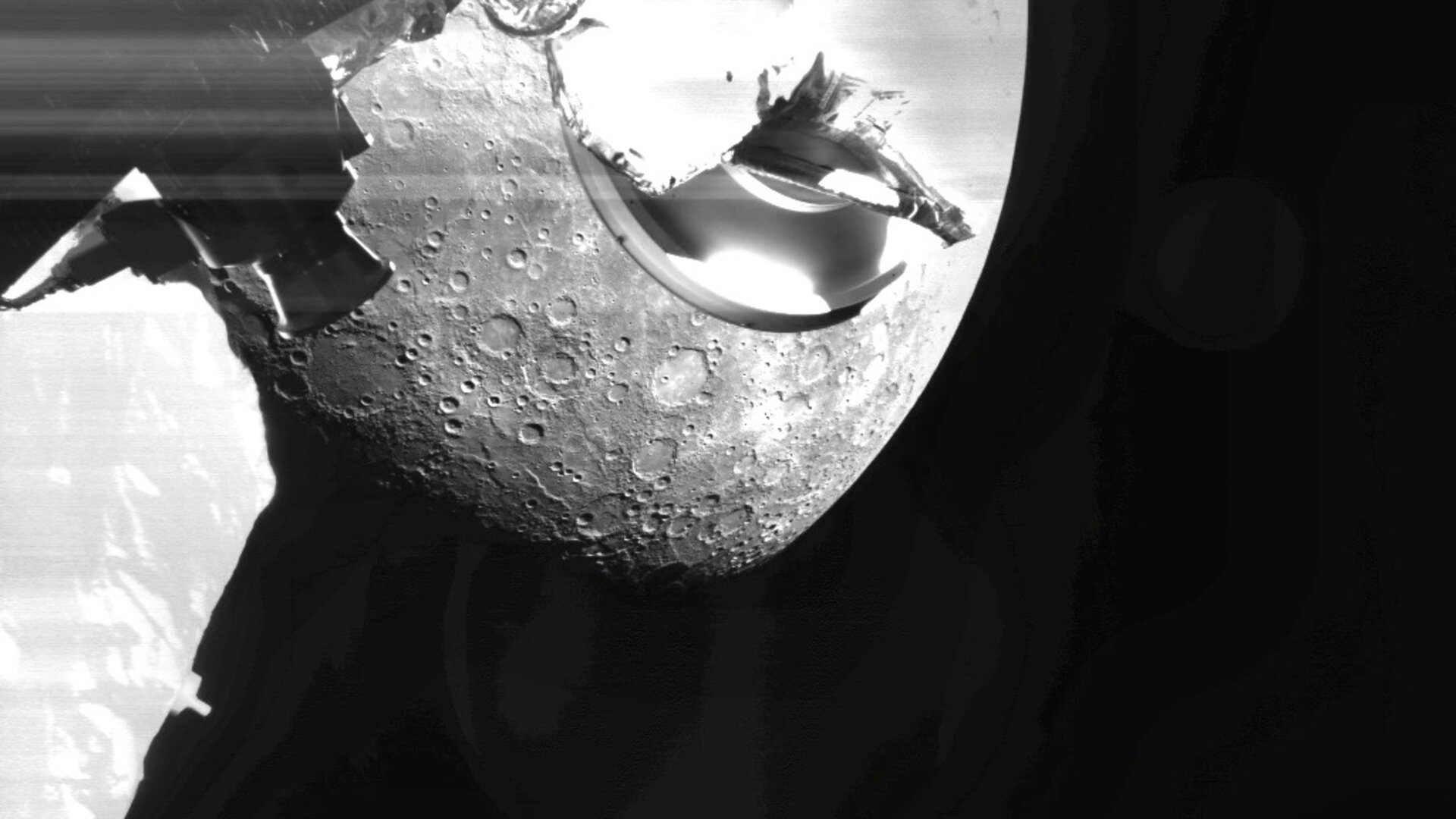
Access the video
The PHEBUS ultraviolet spectrometer collected data for an hour around the closest approach, focusing on the elements present in the planet’s extremely low-density atmosphere, or exosphere, which is generated either from the solar wind or from the planet’s surface. Clear peaks of hydrogen and calcium were recorded after the close approach, once BepiColombo exited the shadow of Mercury.

Hydrogen and calcium are just two examples of what can be found in the exosphere; once in orbit around Mercury, PHEBUS will characterise Mercury’s exosphere composition and dynamics in great detail, watching how it changes with location and time. PHEBUS is one of several spectrometers that will study Mercury from orbit to understand its surface composition, including looking for ice in permanently shadowed regions of high-latitude craters.
During the flyby, the Mercury Gamma-ray and Neutron Spectrometer (MGNS) was also operated, detecting bright fluxes of neutron and gamma rays. These emissions are known to be produced by the interaction of galactic cosmic rays with the uppermost surface layers of Mercury, and also provide information about the surface composition. A detailed analysis of the data – also from the Venus flyby – is currently in progress.
Magnetic boundaries
Sensors on the magnetometer boom – the structure seen extending from the Mercury Planetary Orbiter (MPO) in some of the MCAM images – recorded details of the solar wind and magnetic field around Mercury. During this flyby, the magnetometer team were particularly excited to collect data from so close over the planet’s southern hemisphere; so far, only Mercury’s northern hemisphere has been magnetically surveyed by NASA's Messenger mission.
“It’s like having just explored North America and seeing South America through binoculars, but unfortunately having to abort the expedition. As a researcher, you’re naturally curious and desperate to go back,” says Daniel Heyner from TU Braunschweig in Germany, who leads the MPO magnetometer researcher group. “That makes this flyby particularly interesting, as it is the first time that data from the planet’s southern hemisphere close to the surface is available – even if it is just a small sample.”


Access the video
The data has been converted into sound to be audible to the human ear. The resulting sonification captures the changing intensity of the magnetic field and solar wind, including the moment the spacecraft crossed the magnetosheath – the highly turbulent boundary region between the solar wind and the magnetosphere around the planet.
Once in Mercury orbit, complementary magnetic field measurements made by both ESA’s MPO and JAXA’s Mercury Magnetospheric Orbiter (known as Mio) will lead to a detailed analysis of the planet’s magnetic field and its source, in order to better understand the origin, evolution and current state of the planet’s interior. Moreover, the two orbiters will travel through different areas of Mercury’s magnetosphere and on different timescales, measuring simultaneously how the magnetic field changes over time and in space, and its relationship to the powerful solar wind.
In the meantime, Daniel and his colleagues will start to follow up on questions such as: can the characteristics of the magnetic field from the northern hemisphere be easily transferred to the southern hemisphere? Has the magnetic field generated by the dynamo perhaps even changed in the last six years after the Messenger mission – as it continuously does on Earth? The new BepiColombo flyby data – and eventually data from its main science mission – will be compared with global magnetic field models created from the Messenger mission to create the most accurate picture yet of Mercury’s magnetic field.
Feeling the crunch
The Italian Spring Accelerometer (ISA) onboard the MPO recorded the accelerations measured by the spacecraft as it experienced the extreme gravitational pull of the planet during the flyby, and the response of the change in temperature as the spacecraft entered and exited the shadow of the planet. Furthermore, ISA detected the motion of the PHEBUS spectrometer as it clicked back into its ‘parking’ bracket after it completed its operations at Mercury.
This information has also been translated into an audio file.

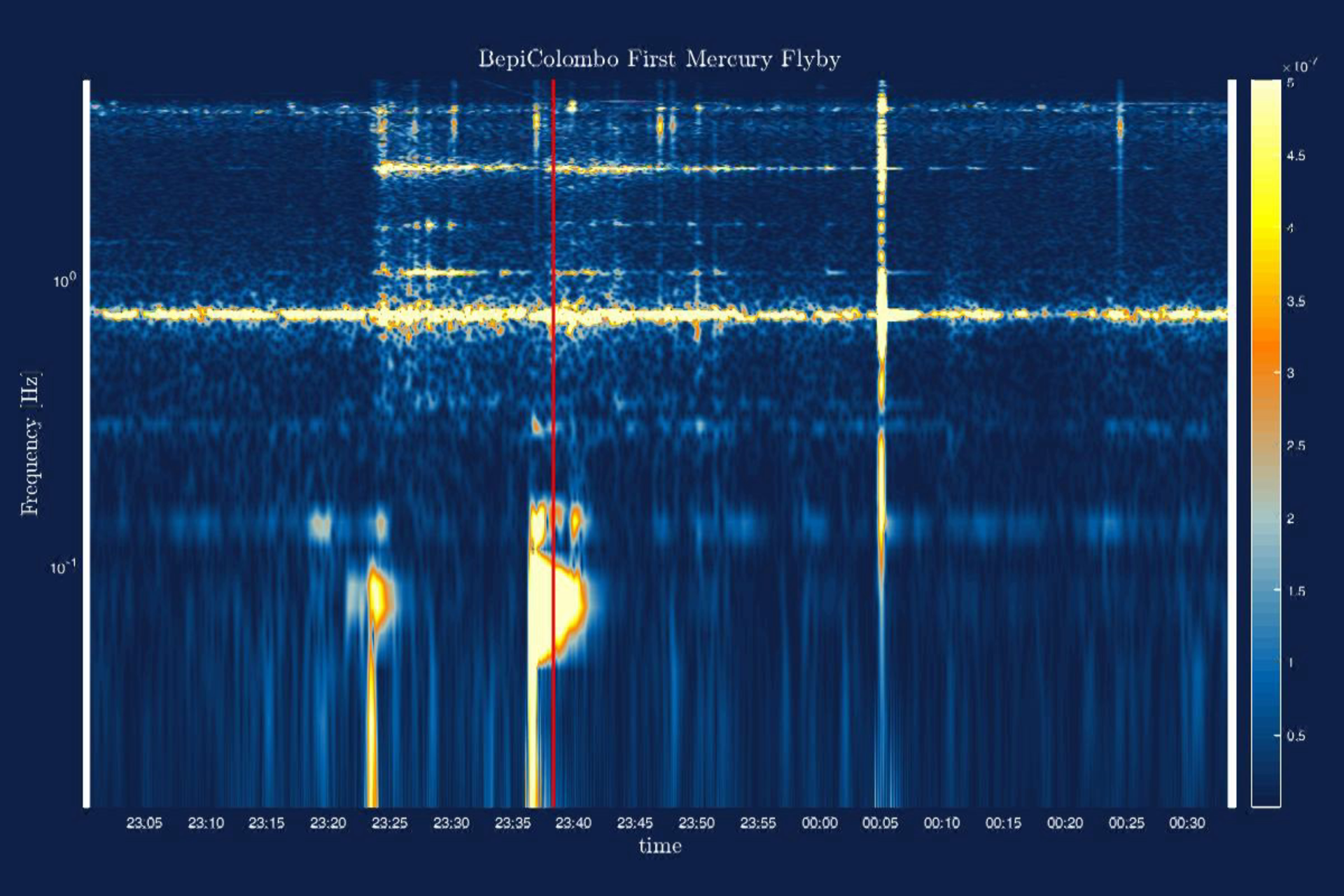
Access the video
“On the acceleration plots that were appearing on our screens, we could see the tidal effects of Mercury on the BepiColombo structure, the drop of the solar radiation pressure during the transit in the shadow of the planet, and the movement of the centre of mass of the spacecraft due to flexing of the large solar arrays,” says Carmelo Magnafico of the Italian National Institute for Astrophysics (INAF). “The real science begins now for us, because in the difference between those expected effects and the actually measured data stands the ISA scientific value. We are extremely happy.”
ISA will support the study of Mercury’s internal structure and test Einstein's theory of General Relativity to an unprecedented level of accuracy. It will also be central to providing accurate orbit determination of the MPO around Mercury, and of Mercury’s centre of mass as it orbits around the Sun.
The October gravity assist manoeuvre was the first at Mercury and the fourth of nine flybys overall. During its seven-year cruise to the smallest and innermost planet of the Solar System, BepiColombo makes one flyby at Earth, two at Venus and six at Mercury to help steer it on course to arrive in Mercury orbit in 2025.
Further science results from the October flyby may be reported in future scientific journals once the science teams have had time to fully analyse the data. All MCAM images are available via the Planetary Science Archive.
Quelle: ESA
----
Update: 27.10.2021
.
BepiColombo completes first Mercury flyby, science provides insight into planet’s unique environment

On October 1, 2021, the joint European Space Agency (ESA) and Japan Aerospace Exploration Agency (JAXA) BepiColombo spacecraft successfully performed its first flyby of the solar system’s innermost planet, Mercury. The flyby is the first in a set of six such events BepiColombo will complete before entering orbit around Mercury in late 2025.
Following the flyby, initial science returns from different instruments onboard BepiColombo revealed interesting details about the environment surrounding Mercury, as well as details on the planet itself.
The flyby
BepiColombo’s first Mercury flyby sequence took place on October 1 and October 2, with the closest approach occurring at 23:34 UTC on October 1 at a distance of 199 km from the surface of Mercury as the spacecraft’s monitoring cameras captured images of the planet.
These same cameras returned images of Venus from BepiColombo’s second flyby of that planet in August 2021.
The three monitoring cameras onboard BepiColombo’s Mercury Transfer Module (MTM) captured images of the planet for four hours beginning approximately five minutes after the closest approach.
While the images of Mercury are visually impressive — with the planet being seen behind some of BepiColombo’s instruments — and stunningly clear, they also allow scientists to identify certain surface craters on the planet and marked the start of the craft’s scientific objectives at Mercury as some regions around the planet will not be accessible once the craft enters orbit; therefore, they have to be studied during the flybys.
“The flyby was flawless from the spacecraft point of view, and it’s incredible to finally see our target planet,” said Elsa Montagnon, Spacecraft Operations Manager for BepiColombo.
As the flyby progressed, several instruments onboard BepiColombo’s modules simultaneously collected data on Mercury and its surrounding environment.
“It may have been a fleeting flyby, but for some of BepiColombo’s instruments, it marked the beginning of their science data collection and a chance to really start preparing for the main mission,” says Johannes Benkhoff, BepiColombo project scientist at ESA.
“These flybys also offer the chance to sample regions around Mercury that will not be accessible once we’re in orbit.”
Mercury’s exosphere
During the flyby, the PHEBUS ultraviolet spectrometer on BepiColombo’s Mercury Planet Orbiter (MPO) module collected data on Mercury’s exosphere — an extremely thin, low-density atmosphere. Currently, the exosphere is thought to exist due to either solar wind or surface material.

This graph shows the amounts of hydrogen and calcium PHEBUS recorded during the flyby. (Credit: ESA/BepiColombo/PHEBUS)
PHEBUS observed the region for an hour. After BepiColombo exited from the shadow of Mercury, PHEBUS recorded sharp peaks of hydrogen and calcium following closest approach. These two elements are thought to be common in Mercury’s exosphere.
What’s more, the Mercury Gamma-ray and Neutron Spectrometer (MGNS) instrument, also located on the MPO, detected bright fluxes of neutron and gamma rays in the exosphere — phenomena often produced by galactic cosmic rays interacting with the uppermost surface layers of a planet.
Additionally, these emissions could provide insight into the composition of the surface of Mercury.
The BepiColombo science team is currently performing a detailed analysis of the MGNS data as well as the MGNS data from BepiColombo’s second Venus flyby in August.
Once in orbit around Mercury in 2025, PHEBUS and the MGNS will continue to investigate the planet’s exosphere — characterizing its composition and dynamics in great detail. PHEBUS will also watch for changes in the exosphere location over time as well.
Mercury’s magnetic field and solar wind
Due to Mercury’s close proximity to the Sun, one might expect the planet to be often blasted with solar wind that is ejected from the Sun’s corona. However, Mercury’s magnetic field, like Earth, helps shield the planet from the full force of coronal ejections.
Until BepiColombo’s flyby, only the northern hemisphere had been magnetically surveyed by a spacecraft, leaving scientists without an answer to how the planet’s magnetic field and solar wind interacted at Mercury’s southern hemisphere.
During BepiColombo’s flyby, sensors located on the spacecraft’s magnetometer boom recorded data on Mercury’s magnetic field and solar wind as the craft zipped past the planet’s southern hemisphere.
“That makes this flyby particularly interesting, as it is the first time that data from the planet’s southern hemisphere close to the surface is available – even if it is just a small sample,” said Daniel Heyner from TU Braunschweig in Germany, MPO magnetometer researcher group lead.
BepiColombo teams took the magnetometer data and converted it into a sound audible to the human ear. The audio captures the changes in the intensity of the magnetic field and solar wind as well as the moment BepiColombo crossed the magnetosheath — the border region around Mercury where the planet’s magnetosphere and solar wind interact in a highly turbulent way.
Once in orbit, measurements taken by these instruments will be used to perform a detailed analysis of Mercury’s magnetosphere, allowing scientists to get a glimpse into the origin, evolution, and current state of the planet’s interior.
Accelerations and temperature changes
As the flyby progressed, BepiColombo’s Italian Spring Accelerometer (ISA) instrument, located on the MPO module, recorded the spacecraft’s accelerations as Mercury’s gravitational pull tugged on the craft.
The ISA also recorded the temperature change BepiColombo experienced as it entered and exited the shadow of Mercury. These measurements are similar to those taken by the ISA in August as the mission performed its second Venus flyby.
Like the magnetometer data, the BepiColombo team was able to translate the ISA data into an audio file.
“On the acceleration plots that were appearing on our screens, we could see the tidal effects of Mercury on the BepiColombo structure, the drop of the solar radiation pressure during the transit in the shadow of the planet, and the movement of the center of mass of the spacecraft due to flexing of the large solar arrays,” says Carmelo Magnafico of the Italian National Institute for Astrophysics.
In orbit, the ISA will support a study of Mercury’s interior structure and will test Einstein’s theory of General Relativity with great accuracy. The instrument will also measure Mercury’s center of mass as it completes its 88-day orbit around the Sun.
Additionally, the ISA will be used to provide accurate details on the orbit of the MPO component of the mission.
BepiColombo’s second Mercury flyby will occur on June 23, 2022.
Quelle: NS
